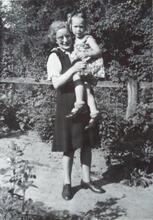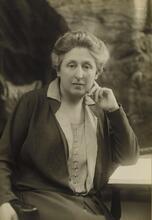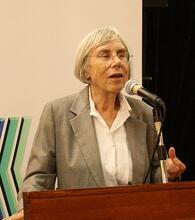Lawyers in Germany and Austria
Women only began to be admitted to law programs at universities in the late nineteenth century, but they were functionally not allowed to get jobs in the field of law until the mid-1920s. Although women were a small proportion of all lawyers, judges, and prosecutors in Germany and Austria, Jewish women were a significant group among those women, and they often faced both religious and gender-based discrimination. The groups following the first female law students started to build a network among themselves, especially in response to well-established male mentoring and fraternal organizations. However, women lawyers were soon pushed out of their jobs by the rise of the National Socialists in Germany in 1933 and in Austria in 1938.
Introduction
Even more than medicine and other male-dominated professions, law was a notoriously difficult field for women to break into in Germany and Austria. Since women lawyers were admitted to German bar examinations only in 1922, they had very limited opportunities to establish themselves in legal careers before the Nazi era. Therefore, although a disproportionately high percentage of women law students in Germany and Austria were Jews, very few Jewish women actually practiced law.
According to official census data, fifteen Jewish women made up forty percent of the women lawyers in Prussia in 1925 and thirty-two Jewish women comprised thirteen percent of all women lawyers in Germany in 1933. In 1938, on the eve of the Anschluss, there were probably nineteen Jewish women practicing law in Vienna. A few of these lawyers qualified as judges at the lowest court level; others worked in male-owned law practices or as legal aid counsellors. Some women with law degrees pursued careers in journalism or other non-legal fields.
Opening of Law Schools to Women
Before the end of the nineteenth century, women were allowed to be only auditors at German and Austrian universities; they were not eligible to take professional examinations or obtain university degrees. (See Higher Education In Central Europe.) In Austria, women began to be admitted as fully matriculated university students in 1897, while in Germany women were accepted as full-time students in the first decade of the twentieth century; indeed, Prussia agreed to admit women to its universities only in 1908. Although some women, including several Jews, received doctorates in law from German universities before World War I, careers in law remained closed to women because women were at first not permitted to sit for state bar examinations.
Only in Bavaria, where matriculation opened in 1903, did no regulation prevent women from taking the first State Examination; nevertheless, the first few graduates in law appear to have believed they were barred and therefore applied for special permission to take it. The other German states finally allowed women to sit for the first State Examination from 1919 until April 1922, when the German parliament finally passed a law to open both State Examinations and the law professions for women. In Austria, however, women were not admitted into the law faculty until after April 1919.
Unlike the United States in the nineteenth or early twentieth century, where aspiring lawyers could do a clerkship in a law office or attend law school at night and then pass a state bar examination, in Germany lawyers always had to be university graduates, generally with a doctorate in law, and then pass two separate bar examinations. Only full-time matriculated students, after completing their required coursework, could sit for the university examinations that qualified them for the first state bar examination. The second State Examination, which qualified lawyers for admission to the bar, normally took place after three years of legal training in a law office or courtroom as Referendare or law clerks. After passing the second state examination, aspiring lawyers were appointed as unpaid probationary lawyers (Assessoren) and could choose either to become lawyers in private practice or to apply for a permanent judicial appointment. Since women were excluded from all the required examinations, they could not become full-fledged lawyers or judges in Germany before the mid-1920s.
Austrian lawyers completed their studies with a doctoral defense that did not require a lengthy thesis as in Germany. They needed to pass three written and oral examinations in order to receive the degree of Doctor of Law. Afterwards, law candidates participated for six years in a poorly paid legal training program in a court or a law office before being able to establish themselves as a full-fledged lawyers or judges.
Jewish Women in Law
The percentage of Jewish women among the female law students at German and Austrian universities before the Nazi era was very high. In 1918/19, the first year that women were admitted to the law faculty in Austria, thirty-one Jewish women made up fifty-two percent of the women law students at the University of Vienna. Ten years later, one hundred and thirty-one Jewish women comprised sixteen percent of all women students enrolled in law faculties in Germany. Jewish women lawyers thus made up a large proportion of the first generation of German-speaking women lawyers. However, in 1933 women lawyers made up less than two percent of all lawyers and less than one percent of all judges and prosecutors in Germany.
At the time of Hitler’s takeover of Germany, three thousand Jewish men constituted roughly sixteen percent of all German lawyers and a much higher proportion in large metropolitan areas; in March 1938, before the German Anschluss prohibited Jews from practicing law in Austria, Jews comprised sixty-two percent of Viennese lawyers. Many Jewish women lawyers, especially among the first generation, were the daughters of lawyers, following in their fathers’ professional footsteps. Among the women lawyers born before the turn of the century almost twice as many Jews had attorneys as fathers as compared with their non-Jewish counterparts.
Female law students—of whatever faith—were usually exceptionally competent in their studies and finished university with grades that far outmatched the average grades of their male colleagues, even their male Jewish colleagues. Yet they often had to work harder in order to make their way. Attempting to gain acceptance into the male bastion of the law schools, Jewish female law students encountered more discrimination directed against them as women than as Jews. At least regarding Germany, the existing memoirs of Jewish women seldom contain stories about antisemitism, whether in school or in university, in the first few decades of the twentieth century. This of course changed in the early 1930s, when they were more likely to be discriminated against for being Jewish than for being women. According to Austrian memoirs, however, Jewish women experienced discrimination both as women and as Jews before the German Anschluss.
Interwar Period
Finally, armed with their university education and their doctorates, aspiring lawyers set off into the working world. Marie Munk and Margarete Berent, two of the early female law graduates in Germany, completed their law studies with a Doktor iuris degree, but were not admitted to the state examinations before World War I. Like other female pioneers in law, they had very limited opportunities to establish themselves in legal careers; they received no guidance whatsoever from university, family or women’s organizations.
In 1928 Marie Munk, a judge’s daughter who was baptized as a child, wrote a pamphlet entitled “Women in Law” that was printed and distributed to secondary school students. It summarized the program of study and requirements for the practice of law as private practitioners, in the judiciary and in government administration. It also included opportunities for women in legal aid clinics, as well as social work, journalism and teaching. In this pamphlet, Marie Munk presented the range of professional possibilities available to women lawyers in Germany. Nearly all women lawyers worked in at least one of these fields; some, like Marie Munk and Margarete Berent, worked in all of them over the years, gaining experience in the early days of a new professional field between social work and law, offering help especially to women and children.
In 1922, following World War I and the passing of the new constitution in 1919, female law graduates were finally guaranteed the right to enter the classical law professions in Germany. The decision was prompted by pressure from the woman’s movement, especially the German Women Lawyers’ Association (Deutscher Juristinnen-Verein, e.V.), established in 1914 by Marie Munk, Margarete Berent and another Jewish woman lawyer, Margarete Muehsam-Edelheim, née Meseritz. Not many of the women lawyers who had already attained their doctorates ten years earlier had the initiative and the courage to brush up on many of the forgotten subjects in order to take the bar examinations. Some, like Margarete Berent and Marie Munk, took a bar review course, passed the examinations with excellent grades, and established private law practices in the mid-1920s. In the early years they handled mainly women clients and poor people.
But to assume that women lawyers dealt only with family law, especially divorce, custody, adoption, support and separation disputes, as is sometimes suggested, is to do them an injustice. Women lawyers worked in as wide a range of legal fields as their male colleagues. It is true, however, that many members of the first generation were actively engaged in the women’s movement and tried to promote legal equality for women and children by reforming marriage legislation and juvenile law. A few shared law offices with their fathers; others went into joint practice with their lawyer husbands. In addition to the women mentioned above, female Jewish attorneys admitted to the bar in Germany in the late 1920s included Leonie Steger in Hamburg; Henriette Frank in Essen; Anna Stewart (née Selo), Elisabeth Kohn and Edith Schulhöfer in Munich; Erika Sinauer in Freiburg/Breisgau, Anita Eisner, Charlotte Grünstein, Betty Fink, Ella Auerbach and Elise Jaffé in Berlin. Martha Garelik and Clementine Bern-Zernik were among the Jewish women lawyers in Vienna.
Women lawyers frequently engaged in charitable activities, alongside their legal careers. Since many decided to study law in order to help socially disadvantaged people—especially poor women and children—they often found their professional home in areas related to social work, a field in which male lawyers were less likely to engage. Furthermore, most of them remained at the bottom of the legal professional career ladder and rarely received promotions in larger law firms in the few instances when they obtained employment in one. As a result, women lawyers did not at first present serious economic competition for their male colleagues.
Many of the women lawyers originally dreamed of becoming judges, especially in the juvenile court. Among the very few women appointed as judges in Germany before the Nazi era were several lawyers of Jewish origin, including Hedwig Brann-Frank in 1928 in Frankfurt/Main, Gertud Else Rahel Samulon-Guttmann in 1929, Erna Haslacher and Marie Munk in 1930 in Prussia.
By the interwar years, the German states were willing to appoint unbaptized Jewish lawyers as judges or prosecutors, but the state did make distinctions when appointing equally qualified male and female Gerichtsassessoren into secure professional positions. Women lawyers had to overcome many more obstacles and usually had to wait several years longer than their male counterparts before being appointed to a “life-time” salaried position as a judge. Significant prejudices against women judges prevailed, especially in the countryside, in penalty cases or in cases of a judge sitting alone. Married members of the state civil service faced particularly difficult situations due to the sporadically enforced regulations against “double earners.” In Austria the first female judge received her appointment only after World War II.
Although many women received their doctorates in law in Germany or in Austria, very few overcame the discrimination against them in academic hiring. In interwar Germany only one female lawyer—Magdalene Schoch, a Catholic—managed to get her Habilitation in law in 1932 and to become a tenure-track faculty member. However, in the lower professional academic ranks some women lawyers, including several Jews, worked for professors as junior faculty members or research assistants. Among these women were Eleonore Mann, Jenny Blasbalg and Eva Veilchenfeld in the Faculty of Law in Berlin, Margot Levi in Bonn, Erika Sinauer in Freiburg and Lise Liebreich in Kiel and Berlin.
Even in these low-ranking positions, women had to work harder in order to make their way into academia, since they were largely excluded from the male academic mentoring system and from the fraternal organizational networks. Thus, Jewish and Christian women lawyers started to build their own fragile network among themselves, creating the German Women Lawyers’ Association and advocating the expansion of opportunities for female law graduates within the legal professions. Naturally none of the first female law students could look to other women at university as their role models or advisors. But these first women lawyers sometimes served as mentors for other women, as did Martha Mosse for the more junior law student Emily Melchior (Braun) in Heidelberg.
Nazi and Postwar Eras
Jewish women lawyers had very few years to establish themselves in legal professions in Germany or Austria before the Nazi era. Nevertheless, some of them succeeded in starting promising legal careers that were interrupted by the Nazi seizure of power. Soon after Hitler’s takeover of Germany in 1933 and the Anschluss in 1938, Jewish women lawyers lost their jobs as judges, civil servants or attorneys, both because they were Jews and because they were women. Often earlier than their male Jewish colleagues, they were dismissed from the state service and denied the right to practice law. Several, including Ella Kessler-Reis and the former judge Gertrud Else Rahel Samulon-Guttmann, lost their lives in the Holocaust, but the majority managed to emigrate. Some of the German and Austrian émigrées to the United States, including Margarete Berent, returned to practicing law, but fewer did so in Great Britain and virtually none in France and Palestine/Israel.
Three European Jewish women became professors of law after World War II: Helen Silving-Ryu in Puerto Rico, Brigitte Levy Bodenheimer in Utah and Käte Wallach in Louisiana. Some women returned to Germany and Austria after the Holocaust in order to continue their legal careers. Erna Proskauer practiced law in Berlin, Käthe Loewy Manasse became a judge in Hamburg, Nora Platiel, a judge in Kassel, and Margarete Eisenstädtler Haimberger-Tanzer served as a municipal judge in Vienna. More typically, however, women lawyers educated in Europe found work in exile as librarians, journalists, secretaries or social workers. Whether in Central Europe or North America, law was an extremely difficult field for women in the early twentieth century, but a few exceptional Jewish women lawyers succeeded despite all the odds against them.
Albisetti, James. “Portia ante Portas: Women and the Legal Profession in Europe, ca. 1870–1925.” Journal of Social History (Summer 2000): 825–857.
“Frauen jüdischer Herkunft an bayerischen Universitäten. Zum Zusammenhang von Religion, Geschlecht und ‘Rasse.’” Häntzschel, Hiltrud & Bußmann, Hadumod (eds.). Bedrohlich Gescheit. Ein Jahrhundert Frauen in der Wissenschaft in Bayern. Munich: 1997.
Freidenreich, Harriet Pass. Female, Jewish, and Educated: The Lives of Central European University Women. Bloomington: 2002.
Huerkamp, Claudia. Bildungsbürgerinnen. Frauen im Studium und in akademischen Berufen 1900–1945. Göttingen:1996.
Huerkamp, Claudia. “Jüdische Akademikerinnen in Deutschland 1900–1938.” Geschichte und Gesellschaft 19 (1993), 311–313.
Kaplan, Marion A. The Making of the Jewish Middle Class: Women, Family and Identity in Imperial Germany. New York/Oxford: 1991.
Kimble, Sara, and Marion Röwekamp. “Exclusion and Inclusion in the Legal Professions: Negotiating Gender in Central Europe, 1887-1945.” Gender and Science in East-Central Europe, Acta Poloniae Historica 117 (2018), 52–93.
Sara L. Kimble and Marion Röwekamp (eds.). New Perspectives on European Women's Legal History (Studies in Gender and History series). New York/London: Routledge, 2017.









